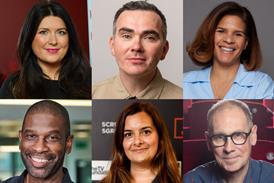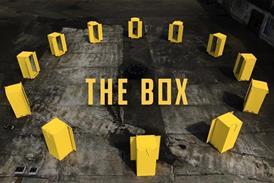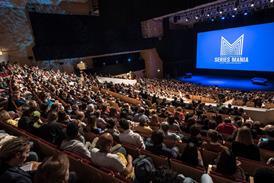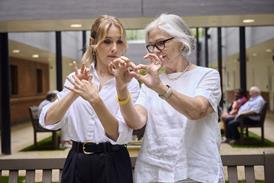From “this year’s Notes On Blindness” to the Doom Room, Tom Grater explores the fest’s VR offering.
This year’s crop of virtual and augmented reality experiences at Sheffield Doc/Fest is an impressive showcase of works that push the boundaries of the fledgling medium.
Housed in the Alternate Realities programme, the selection ranges from stories of sex workers in Mexico, to ingenious tribes in the heart of the Amazon rainforest, and journalists imprisoned in Iran.

For Dan Tucker, who is presenting his first selection as Doc/Fest’s Alternate Realities curator having joined the festival in January, this year’s programme is about inspiring positive change.
“One of our essential themes this year is celebrating unity, not division,” he says, adding that he has tried to tap into the festival’s overall focus of ‘resistance and change’.
“We live in a world confronted with division, and horrible acts that lead to more division. Film programmer Luke Moody and I wanted to find content that would bring people together. Content that made people more aware of the lives of others and gave them more empathy for others,” he adds.
Empathy
Undoubtedly one of VR’s most used buzzwords, empathy is present across the Doc/Fest selection, with many of the experiences allowing the user to step into the virtual shoes of another, to experience their life first-hand.
One project that fits into that category is Unrest VR, a window into director Jennifer Brea’s struggle with the illness ME (Myalgic Encephalomyelitis), often referred to as Chronic Fatigue Syndrome.
Placing the user in a simulation of Brea’s bedroom, the director’s narration accompanies the journey through the often overlooked and virtually untreatable condition.

There are similarities with one of Sheffield Doc/Fest’s best VR experiences in 2016, Notes On Blindness, a film about the narrator losing his eyesight, which shares thematic similarities.
Unrest VR was co-produced by Arnaud Colinart of French studio Agat Films Ex Nihilo and co-directed by Amaury La Burthe, who worked on the Notes On Blindness VR film.
After their latest project, it’s clear that they are forging their own, impressive VR identity.
Window into another world
Tucker is keen to stress that must not forget the format’s limitations. “There’s a lot of expectation on VR, as if it’s going to solve the world’s ills, but that’s far too much pressure to heap on such a burgeoning and new artform.”
Despite this, VR has certainly been embraced by activist communities, who are using it as they would traditionally use documentary films, to place users closer to issues.
In Munduruku: The Fight To Defend The Heart Of The Amazon, from directors Grace Boyle and James Manisty and producer Pete Speller for Greenpeace, the viewer sits in a large wooden structure (designed by London 2012 Olympic opening ceremony designer Mark Tildesley) before donning a headset and being transported to the Amazon rainforest.

The film is not just a well-crafted 3D video, it also has several other dimensions. During the experience, an attendant supplements the visuals and sound with temperature controls and, crucially, smells, which were specially commissioned from a professional parfumier who visited the Amazon to inspire the creation of the scents.
Combining crisp footage with sensory triggers, the overall experience is an intoxicating vision of the rainforest, and its message of preservation is stronger because of the added immersive elements.
In Trafficked, created by Owain Rich and Charlie Newland for the BBC, the user is transported into the life of a woman who spent eight years in forced prostitution after being taken from her home in Nicaragua.
As an animated VR experience, viewers will be reminded of Shaun The Sheep creator Aardman’s first foray into VR, We Wait (also made with the BBC), which depicted a migrant’s dangerous journey across the sea and played at Doc/Fest last year.
Tackling tough issues
Tucker emphasises that while he was keen to highlight important social issues, he was also conscious that, as VR films currently do not receive age-ratings, he had a responsibility to be wary of distressing viewers.
“There has been some very challenging content recently – sometimes that can be really overwhelming. We need to make great content that challenges the mind but doesn’t challenge the stomach. You have to be conscious of how you treat your visitors,” he says. “People are talking about VR ethics now, and potential ratings.”
One of the more challenging projects on offer this year is DeathTolls Experience from Ali Eslami, which premiered at IDFA last year. The film is a conceptual, visual depiction of the casualties of the bloody conflict in Syria and the refugee crisis in Europe.
Similarly challenging is Blindfold, Navid Khonsari and Vassiliki Kohnsari’s film which places the user into Iran’s notorious Evin Prison, where they embody a journalist who is psychologically tortured into signing a confession for committing crimes against the state.

The film, which is having its world premiere at Doc/Fest, is particularly impressive because of its simple yet effective approach to interactivity.
Early on, the parameters of the experience are set by the user’s tormentor informing them that they are gagged, thus unable to talk, and can only respond ‘yes’ or ‘no’ to questions through a nod or a shake of the head.
This simple mechanism, controlled by a sensor in front of the viewer, adds a strong level of immersion that many VR films lack. After completing the experience, users will be desperate to try again to see if they could have created a better outcome.
A message of hope is found in the guise of Future Aleppo, an art project and VR experience from director-producer Alex Pearson and producers Zahra Mackaoui, Eleanor Whitley with design studio Marshmallow Laser Feast.
The project, having its world premiere at Doc/Fest, tells the story of teenager Mohammed Kteish who, as bombs fell on his hometown of Aleppo during the ongoing conflict in Syria, dreamed up a re-built version of his city in the form of a paper model.
The VR experience, which was co-commissioned by Doc/Fest and Liverpool-based arts and cinema venue FACT, allows Mohammed to take the user on a virtual guided tour of his project.
Doom Room
The most attention-grabbing and unconventional (if there are any VR conventions yet) experience on show at Doc/Fest this year is Doom Room.
Combining immersive theatre with virtual reality, the highly ambitious 40-minute adventure into the dark and strange is not for the faint-hearted – it involves fake blood, nudity, and satanic rituals, and that’s before you even enter the VR component.
After donning the headset, and accompanying hooded cloak, the viewer descends into an alarming anthology of disturbing sequences that, while seemingly disparate, combine to produce an impressively emotive effect on the user.
Whether it’s swimming with sharks, receiving a lapdance from a chubby man, or shooting yourself in the face with a rifle, the experience is guaranteed to provoke a visceral reaction from any type of audience.

Doom Room was made by Danish VR studio Makropol, directed by Jesper Dalgaard and produced by Mads Damsbo. It played in Copenhagen at the beginning of this year before travelling to Doc/Fest.
Where next for VR?
Looking forward, Tucker says that the medium is “changing very rapidly”, and it is comfortable with the fact that “no-one is going to make a fortune from making VR yet”.
“No one was making millions out of film, TV or radio in the beginning – it takes a long time to acquire an audience,” he comments.
While he admits that commercial opportunities are currently limited, he highlights that more funding opportunities are emerging. “We’re seeing more pots of money, and more beyond the traditional organisations such as Google and HTC, there’s public money being made available.”
He predicts that for the near future, the strongest VR will be location-based experiences.
“There’s nothing wrong with that, when people first experienced cinema they went to the cinema,” he says, adding that “we are going to see more and more VR exhibitions”. Recent examples include Alejandro Inarritu’s Carne Y Arena, which premiered at the recent Cannes Film Festival and now has a residency at the Fondazione Prada art institution in Milan until December 2017.
Tucker also predicts that tours of VR selections will become more regular, following Doc/Fest’s move to tour nine of this year’s VR experiences, including Munduruku and Trafficked, across Latin America later this year.
The accessibility of content remains a barrier to VR becoming a mainstream medium, with few opting to invest the money in a decent home system. However, as exhibitions and tours become more frequent, the general population will start to be exposed to the medium on a more regular basis.
For Tucker, the key focus for VR filmmakers should remain on the quality of the films they make, “People need to make profound content, and hope that content is recognised.”
“This is going to grow and grow,” he predicts.






























No comments yet